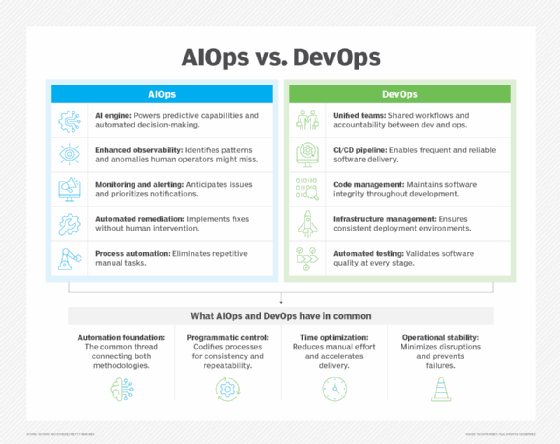
Getty Images/iStockphoto
AIOps vs. DevOps: Distinct approaches to IT automation
AIOps and DevOps are powerful methodologies that differ in approach yet share the common thread of automation.
Automation is the common denominator of AIOps and DevOps, two IT practices reshaping how organizations develop, deploy and maintain their digital infrastructure. While both methodologies use automation to boost efficiency and reduce risk, they do so through distinctly different approaches and varying objectives.
This comparison explores the fundamental similarities and critical differences between AIOps and DevOps, clarifying how the methodologies can work together to optimize an organization's IT operations.
What is AIOps?
AIOps integrates sophisticated AI capabilities directly into IT professionals' daily workflows. By embedding AI into operational processes -- from deploying software and provisioning servers to interpreting monitoring data -- AIOps delivers two crucial benefits: significant time savings and a dramatic reduction in manual effort.
When Gartner coined AIOps in 2016, it initially stood for algorithmic IT operations, reflecting an early focus on algorithmic automation. It was only later that the term evolved to mirror the growing interest in AI systems across the technology landscape.
While most current discourse centers on AI-powered IT operational capabilities, it's worth noting that AIOps implementations vary considerably in sophistication. Not all AIOps tools use advanced AI technologies, like machine learning models, despite the category's name suggesting otherwise.
What is DevOps?
DevOps creates a close partnership between software development and operations teams. This integration establishes a smoother software delivery workflow by ensuring both groups understand each other's work and collaborate to support their respective needs.
The concept of DevOps gained popularity in the early 2010s. Historically, developers -- i.e., the people whose main job is to write code -- worked in isolation from operations engineers, who deploy and manage the code. This resulted in a problematic divide. Developers had minimal visibility into production challenges, while operations teams remained largely unaware of upcoming software changes until deployment was imminent.
By breaking down barriers between teams, DevOps creates cross-functional accountability for the entire software lifecycle, from initial concept to production performance.

AIOps vs. DevOps: Key differences
While AIOps and DevOps represent transformational approaches to IT management, they operate with fundamentally different objectives, tool sets and operational scopes.
Strategic focus and objectives
Here's how AIOps and DevOps compare in terms of strategic focus and objectives:
- AIOps. Integrates AI into IT operations, often using advanced analytics and machine learning to enhance operational efficiency.
- DevOps. Pursues cultural and organizational transformation, creating unified collaboration in software delivery.
Technology implementations
The two also differ in the tool sets and frameworks they use:
- AIOps. Relies on configuration management and monitoring software with embedded AI capabilities -- this software enables automated anomaly detection, predictive analytics and intelligent alerting systems to identify potential issues before they affect operations.
- DevOps. Focuses on CI/CD frameworks, version control systems and deployment automation tools for streamlining the SDLC.
Operational scopes
Finally, here's how AIOps and DevOps compare in terms of scopes:
- AIOps. Can extend across the entire IT landscape, including infrastructure management, network operations and security monitoring.
- DevOps. Maintains a narrower scope that addresses the software development and deployment pipeline.
Thus, comparing AIOps to DevOps is like comparing apples to oranges. They're fundamentally different approaches that serve different purposes, yet both are valuable practices in IT operations.
Automation as a common thread
If there is one key area where AIOps and DevOps overlap, it's their shared focus on automation.
Automation is the fundamental purpose of AIOps. The entire methodology revolves around using AI to automate complex, resource-intensive IT processes.
While DevOps isn't inherently dependent on automation, it has evolved to embrace it as a critical enabler. Though DevOps philosophy centers on cultural transformation and collaboration, automation serves as the practical mechanism that makes this collaboration truly effective. By automating repetitive tasks, DevOps teams establish consistent workflows that create a shared operational language between developers and operational professionals.
How DevOps can use AIOps
DevOps teams can function independently of AI-powered tools, but integrating AIOps into their workflows often makes sense, as in the following use cases:
- Advanced observability. DevOps teams that monitor applications can use AIOps tools to identify patterns and anomalies that might otherwise go undetected.
- Intelligent incident response. AIOps transforms incident response from reactive to predictive. Rather than manually troubleshooting, DevOps engineers can deploy AI systems that automatically diagnose root causes and implement remediations.
- Dynamic infrastructure management. AIOps tools assist DevOps teams in making infrastructure scaling decisions by analyzing complex usage patterns and performance metrics.
Traditional scripting can also automate many DevOps operations, but integrating AIOps software into the DevOps tool set provides powerful and flexible automation. Using ready-made AIOps software eliminates the need for DevOps teams to build and maintain custom automation systems.
AI vs. automation vs. algorithms in AIOps and DevOps
While this article has discussed the role that automation and AIOps can play in DevOps, it's touched only briefly on the specific nature of the AI technologies involved. That's because not all automations require sophisticated AI. Plus, not all AI-driven automation capabilities require the complex generative AI and agentic AI technologies that dominate the AI scene today; some use simpler forms of AI, like rules-based decision-making.
As noted earlier, the original concept of AIOps was rooted in using algorithms to help automate IT processes -- only later did it become shorthand for AI-assisted IT operations. Likewise, DevOps automations historically relied on straightforward approaches, like scripting and infrastructure-as-code tools, rather than complex AI systems.
As AI technology advances, both methodologies have begun incorporating more powerful AI capabilities. For example, some AIOps tools now use natural language processing for interacting with observability data, while DevOps teams increasingly deploy agentic AI to automate complex infrastructure and deployment tasks.
Despite these advancements, organizations should recognize that sophisticated -- and expensive -- AI technologies aren't mandatory components of either AIOps or DevOps strategies. Simpler automation approaches using basic algorithms remain viable and might offer better cost-efficiency in many scenarios.
Bringing AIOps and DevOps together
Here's the bottom line: While DevOps represents a way of life for the entire organization, AIOps employs advanced tools and technologies that can significantly enhance DevOps automation efforts. By understanding the wide variety of underlying AI technologies across different platforms, DevOps teams can make informed implementation decisions that align with specific operational needs and budget constraints.
Chris Tozzi is a freelance writer, research adviser, and professor of IT and society who has previously worked as a journalist and Linux systems administrator.








